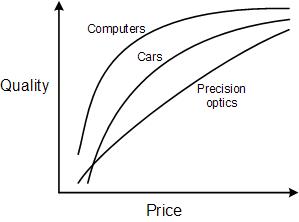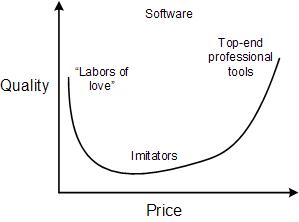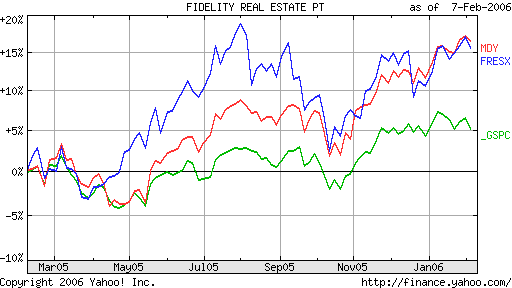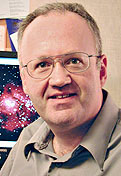 |
|
|
Popular topics on this page:
Could the whole world fit in Texas?
Cleaning vinyl records
Astrophysics for the amateur (Adam Block)
Beware of mid-priced software
Nonparametric statistics
Should the University podcast its lectures?
Astronomical photographs:
Saturn
Nebulae
Scroll down or press Ctrl-F to find other topics, or check previous months.
BOOK SALE - I'm selling off some scholarly books via Amazon Marketplace. Have a look!

|
2006
February
26-28
|
End of month
I'm way too busy to write anything substantial right now.
Instead, read
this
interesting think piece
about the decline of the Democratic Party
(possibly caused by the Internet)
or
this
report on an interesting new camera
(a DSLR with continuous live LCD viewing).
See you in March!
Permanent link to this entry

|
 |
2006
February
24-25
|
Cleaning out the inbox
My motto for today is a quote from Henry Kissinger: "There cannot be
a crisis this week. My schedule is already full."
Is obligarchy a word?
See Jim Mischel's comments.
So far, I haven't been able to turn up any more information than he did.
We know about oligarchy, which means "government by the few."
But Susan B. Anthony spelled it obligarchy in a speech, and a few activists
have done so since.
We don't know if this is an intentional pun or just a mistake.
You may have heard recently that
ancient speech was recorded on pottery
by someone who was turning a vase on a potter's wheel
and using a sharp-pointed tool
which picked up vibrations from the air and acted like a phonograph cutting needle.
Well, it wasn't,
although the idea has been kicking around for 20 or 30 years.
I recall being told that it originated in a science fiction story.
In a break with tradition and with common sense, the recording industry is now trying to say
that we don't
have a right to copy our own CDs for our own use.
They're on shaky legal ground, and besides, they don't understand why we want to copy
our own CDs for our own use. We aren't wanting exact duplicates, but rather
ease of transport (e.g., on a laptop's hard disk or inside an iPod) and the ability to
select songs and hear them in a particular order.
A time-honored principle of copyright law is that if you have the right to read something,
you have the right to copy it for your own use (not for distribution).
And a time-honored fact about the recording industry is that it has tried to shoot itself
in the foot every time there has been a technological advance.
Phonographs were going to kill off player pianos; radio was going to kill off phonographs;
videotape was going to kill off TV; and so forth.
With every advance, the recording industry has actually made more money than ever.
But every one of the advances was opposed.
Listen to this –
the classiest weather forecast I've ever heard.
(It even mentions
Rockall.)
Words transcribed here.
I can't guarantee that either of these links will stay active.
Note this page
explaining that the King's Singers weren't behind it.
Permanent link to this entry

|
 |
2006
February
23
|
Should we podcast all our lectures?
Yesterday
NewSource 15,
the University's internal video outfit,
interviewed me about a proposal to
record professors' lectures and put them on the Web.
I think doing this would be of only limited usefulness for many reasons.
First, many lectures, including mine, are useless if you can't see the board.
When I teach, I'm not just pronouncing words, I'm drawing diagrams and writing formulas
constantly.
Admittedly, some lectures would come across well as audio recordings.
Quite a few lectures on history or literature might be quite useful.
To a visually handicapped person, podcasts would be invaluable.
But they're not the solution for everybody.
Second, audio recording isn't as efficient as written notes if you
want to review a lecture.
To listen to a 2-hour lecture takes 2 hours.
You can skim your notes in 2 minutes or review them thoroughly in 20 minutes.
Remember portable cassette recorders in the 1970s?
A few people tried recording all their classes for later review,
and they quickly stopped.
That's why.
Third, you have to be there.
A classroom lecture isn't just a show that I put on.
It's an interaction with the students.
I believe in closing the feedback loop – finding out what's going
on with the students every day and adjusting my presentation to meet their needs.
A few of the initial advocates of podcasting might have had the idea that they
wouldn't have to go to class any more. Nonsense.
Fourth, there are privacy issues.
If I ask a student a question and he answers it incorrectly,
should his answer be broadcast to the public?
No! The audience will have no way to know whether he's really
ignorant, or whether I'm trying to get him to guess something at the
limits of the class's knowledge. His fellow students know, but an outside
audience would not.
There might even be legal issues here.
I might be forbidden to call on students to answer questions at all.
There's also the issue of digressions and blunders made by the professor himself.
My classroom speeches aren't as carefully scripted as President Bush's.
Sometimes I get off topic (often at the request of the students).
And sometimes I make a mistake
(in calculation, programming, or approach to a subject).
To show students how to solve problems, I sometimes plunge right into
one without knowing the answer, and sometimes I go off in the wrong direction.
In front of a live class, I can correct my mistakes.
But I'd hate it if anyone were sifting through recordings of my lectures,
collecting things that look like (and might actually be) mistakes and blunders.
If I had to perform for podcasts, my lectures would be very different from the
informal talks I presently give to my students.
I'd have to prepare formal speeches suitable for a very large audience.
My students wouldn't get nearly as much out of them.
Concerning digressions and blunders, I should add that I do feel that
professors should be accountable to their employers
(in my case, the taxpayers of Georgia)
for their use of classroom time.
Some left-wing political activists explicitly use the classroom as a
political platform, regardless of what subject they're supposed to be teaching.
(They make specious arguments that there is no real boundary between, say, chemistry and Communism.)
I've also seen people use unrelated courses as platforms to advocate
atheism or (much less often) religion.
These practices are improper.
When I get in front of a class, I teach the subject that the University is paying me to teach.
Permanent link to this entry

|
 |
2006
February
21-22
|
One of Georgia's best Mexican restaurants
While on our trip, Melody and I ate at what must be one of the best
Mexican restaurants in Georgia, a small and unpretentious place
called Las Fronteras on Sam Nunn Boulevard in Perry, very
close to I-75, Exit 136. She had grilled
tilapia and I had chicken quesadillas,
both excellent.
That's all for now. We're in the middle of the mid-February work crunch.
A third of the semester is behind us and people are suddenly deciding they'd
better get some work done!
Permanent link to this entry

|
 |
2006
February
18-20
|
How Billy Met Dorothy
I've just had to go to Moultrie, Georgia, on short notice to attend the funeral
of my uncle, William L. Miller, whose son, my cousin, is the prominent Valdosta
attorney David Miller.
While there I learned the full story of how Uncle Billy met Aunt Dorothy (my
mother's sister).
It was 1949. Billy, then aged 22, worked for Swift & Co. in Moultrie.
One Saturday afternoon, he was
riding around in his yellow convertible with some friends.
They asked him, "Who are you going to take to the company dance tonight?"
and he pointed at a girl walking along the street and said, "Her!"
He then followed her into the store where she worked, introduced himself,
and asked her out.
Since she was 15 years old, she had to get her parents' permission, so he
drove her to Crosland for the purpose. Then they went to the dance.
Two years later – with Dorothy still only 17 – they got married.
Permanent link to this entry
Other Moultrie notes
I lived in Moultrie
for a total of about four years as a child, as my father got
transferred there, then away, then back. Somehow, during that short period, I managed
to live in 5 different houses, and on this trip I finally managed to identify one of
them that had been eluding me. The clue was wild bamboo. I remembered that the vacant
lot next to it had been full of wild bamboo, and yesterday, while driving south on Second Street
Southeast, I saw a small clump of bamboo and decided to look around. There was the house.
Of course, the vacant lot was no longer vacant.
Moultrie is a very pretty town – it has a neatness and consistently pleasant appearance
seldom found
in North America. On this trip I was delighted to see that the economy is picking up
and several historic buildings have reverted to their original appearance.
For instance, the old jail, which looks like a castle, has had the paint removed
from its red brick and is now the Chamber of Commerce.
Built in 1915 with indoor plumbing, it probably offered a higher standard of living
to the prisoners than their own homes.
But the old Vereen Memorial Hospital, converted to county offices about 30 years ago,
has disappeared. It was torn down just a few weeks ago.
Permanent link to this entry

|
 |
2006
February
17
|
Nonparametric statistics
Please allow me to talk shop for one day... I think I've worked out a neat way to
explain an important mathematical concept.
Suppose you wanted to know whether ninth-grade boys are, on the average, taller
than ninth-grade girls.
But you can't check all the ninth-graders in the world, so you take a random
sample of ten boys and ten girls. How to ensure that the sample is random is
beyond the scope of this article.
You could compute the mean (average) height of the boys and the girls in your sample,
and you'd surely get 2 different numbers.
But is the difference significant?
That is, does it result from a real difference between all ninth-grade
boys and girls, or is it just a random sampling effect because you
only looked at ten of each?
To find out, you could also compute the standard deviations and then perform a
t-test. That's standard statistical technique.
(For more about significance testing, click
here and
here.)
But the mean, standard deviation, and t-test all assume a normal
(bell-curve-shaped) distribution. They are thrown off excessively if you
have one exceptionally tall person in the set.
So your alternative is to use nonparametric statistics.
The nonparametric statistic that everybody knows about is the median
(individual who ranks midway between tallest and shortest).
But there are others.
Here are two ways to do the nonparametric equivalent of a t-test.
You could line up your 20 people across the front of the classroom from
shortest to tallest.
Then look and see if the boys and girls are evenly mixed, or if there is a
preponderance of girls on the left or on the right.
That is a Wilcoxon test and the
significance level can be calculated several ways.
Or you could arbitrarily pair each boy with a girl, and see how many pairs
have the girl taller than the boy. If it's substantially more than 50%,
then the girls are taller, on the whole.
That's a Mann-Whitney test.
Again, there are ways to compute
significance levels.
In fact, these two tests are provably equivalent and are sometimes
called the Wilcoxon-Mann-Whitney test.
Either way, an exceptionally tall person is not going to have an undue effect.
To be precise, one exceptionally tall person – what statisticians call
an outlier – will only have one person's share of an effect on the
outcome. It doesn't matter how tall he is; the most he can do is outrank all
the others, and then it doesn't matter if he's six feet tall or seven.
Permanent link to this entry
Miscellany
Melody points out, further to yesterday's entry, that because your house is not
an asset unless you're actually ready to sell it,
the current value of your house is not a fair basis
for taxation (thank you, Mr. Jarvis)
nor should it be used on student financial aid applications.
Not all of us are yuppies who get a new McMansion every five years.
Some of us buy a house cheaply, or inherit it, and continue
to live in it while it appreciates. That does not increase
our ability to pay for anything else.
Permanent link to this entry

|
 |
2006
February
15-16
|
Be my what?
What do you think would happen if you gave about 30 co-workers
(both male and female)
red and white cards decorated with Cupids and hearts and
words such as "Be mine"?
A sexual harassment suit, maybe?
What I'm describing is a normal American elementary-school Valentine's Day.
And the other day, one of Cathy's teachers pointed out how strange
this custom looks to foreigners.
It even looks strange to us if we think about it.
Nowadays, most schools require every student to give a card to every student
in the class (so nobody gets left out).
What's the lesson here?
That expressions of affection can be totally meaningless?
Permanent link to this entry
Miscellany
Breathing easier:
Britain's pubs are going smoke-free.
And the number of University of Georgia students who smoke,
even counting very infrequent smoking, is
dropping sharply,
from 25% three years ago to 16% today.
Economic notes for yuppies:
Jim Mischel points out that
your house is not an asset
unless you actually want to sell it.
What matters is not its value on paper, but its effect on your cash flow.
If you can't keep up the payments, it doesn't matter how much it's "worth."
Meanwhile, beware of
bogus bill collectors.
These are perennial problem but seem to have proliferated lately.
This article confirms my impression that people are easy to confuse about their debts;
they're paying things they don't owe, just because somebody says they owe them.
I got related questions back when people were panicking about the Year 2000 Problem.
"If the computer mixes up my bills, what do I have to pay?" Obviously, you have to pay
what you really owe, regardless of what mistaken pieces of paper you get in the mail!
Do people really think a debt exists simply as numbers on a bill?
Finally, The Motley Fool (UK) entertains us with
The Devil's Dictionary of Money.
Permanent link to this entry

|
 |
2006
February
13-14
|
Miscellany
Happy St. Valentine's Day, the day on which birds supposedly start to mate,
according to English tradition. Various saints named Valentinus apparently have nothing
to do with it, except that one of them is honored on the date in question (Feb. 14).
The girl in the flower shop looked at me a bit strangely when I asked for 3 individually
wrapped roses. For Melody, Cathy, and Sharon, of course... who did you think?
I am now famous in Germany due to Stefan Heymann's translation of
this web page
(English original
here).
The German version got more than 100 hits in its first 24 hours.
It's about black-and-white darkroom work and I consider it obsolescent, but the
rest of the world is still beating a path to my URL.
Here
is an incisive comment about hybrid electric vehicles.
While I think hybrids are a good idea, the article points out that their real function is to improve
the average gas mileage of each manufacturer's cars, so that more gas guzzlers can still be sold.
Now that The Da Vinci Code is going to be a movie,
the producer has taken the unusual step of
hosting a web site for people to
criticize it.
Or rather criticize its fictionalized misrepresentation of numerous real people and institutions
(such as portraying
Opus Dei as a murderous cult).
I suppose they think this will get them out of lawsuits.
There are fundamental problems with making fiction out of real people and places and drastically
changing their character, which is what The Da Vinci Code has reportedly done.
(I haven't read the book.)
Being something of a church history buff, I expect another wave of puzzled questions
when the movie comes out.
Permanent link to this entry

|
 |
2006
February
12
|
Beware of mid-priced software
With most kinds of merchandise, the middle of the price range is the best deal.
For half the maximum price, or less, you get more than half the maximum quality.
Here's my subjective impression of how it works for computers (where the $500
Wal-Mart special is awfully close to the $2000 custom system), cars, and
precision optical instruments (which are labor-intensive):

But several recent experiences have convinced me software doesn't work that way.
The two best audio editing programs I've found are GoldWave ($30)
and Adobe Audition ($300).
In between are several products that are inferior to both of these.
I've had the same experience with several graphics and scientific software products.
The mid-priced products are the worst deals.
Here's how I think it works:

That is, the price-to-quality function is U-shaped.
I think I know why. First, software is all design, not manufacturing.
Once you've made one copy, almost no labor is needed to make a million just like it.
So everything depends on the work done by one person or a small team.
Second, inspired software designers – the ones who really invent good
software or good ways of building it – are not very selfish.
They often produce freeware or cheap shareware.
These are "labors of love," created because the inventor wanted to make
the software, not because he wanted to make money.
And if they don't give it away free, if they commercialize it, inspired software
rises to the top end of the price range as the product that is most in demand.
Then the middle of the curve is filled in by non-inspired developers who just want
a share of the market. That gives you the worst of both worlds.
They want money, but they don't have inspiration.
So here's my advice:
- When you buy a computer, pay no more than 60% of the price of the most expensive
one in the store, unless you have special needs. Usually, at 60%, diminishing returns
have set in.
- When you buy software, get either the cheapest respectable
products (OpenOffice, GIMP, GoldWave, Gnu compilers)
– which are "labors of love" for their developers – or else the most highly
regarded professional tools (Photoshop, Audition, Delphi, Visual Studio).
Avoid the middle ground.
But remember that cut-down versions of pro tools are usually very good, such as
Photoshop Elements or the Visual Studio learning editions. These are top-rate software with
specific functions removed. If you can live within their limitations, they're
excellent value for the money.
And, yes, nowadays it is normal to spend more on software than on the computer.
Didn't your CD collection cost more than your CD player? Same principle.
Permanent link to this entry

|
 |
2006
February
11
|
Astrophysics for the amateur?
 Amateur astronomy changed little between 1780 and 1980.
From the time of
Sir William Herschel
(the amateur who turned pro at the request of King George III)
to the Celestron 8 generation,
the emphasis was on visual observing, and the view through the
telescope was about the same.
Amateur astronomy changed little between 1780 and 1980.
From the time of
Sir William Herschel
(the amateur who turned pro at the request of King George III)
to the Celestron 8 generation,
the emphasis was on visual observing, and the view through the
telescope was about the same.
But then the camera began to replace the eye. In the 1990s, amateur
astrophotography began to rival professional work.
(I may be able to take
a little of the credit
for making that happen.)
Then came the digital revolution, which is now practically complete.
The gap between amateur and professional astronomical techniques
that was so wide 50 years ago has narrowed almost to nothing.
Even the size of the telescopes is less of a factor than it used to be,
since a modern CCD camera with a 20-inch telescope rivals the best
observatory equipment of the 1950s.
This was the starting point of Adam Block's talk to the
Atlanta Astronomy Club at Emory University last night.
Melody and I drove over, ate
some of the best pizza in the Southeast,
and went to the meeting.
Adam's talk was about the astrophysically interesting details you can
see in amateur pictures.
The quirks of dust lanes in galaxies, gas clouds emitted by stars,
and the like are now within reach.
It's no longer a matter of looking at a faint smudge in the sky and
then reading, in a book, that large telescopes have found such-and-such
unusual feature in the distant nebula or galaxy.
We can photograph the unusual features ourselves.
The picture tells us more than the reference books.
Above you see one of my own photos, of the nebulae NGC 6357 and NGC 6334
just west of M6 and M7
in Scorpius. Their unusual shapes have a story to tell,
but I don't know what it is.
For many years Adam Block ran the visitor program at
Kitt Peak National Observatory.
He is now setting out to start
America's first commercial observatory,
to sell telescope time and expertise to advanced amateurs and (I suggested) small colleges.
I wish him well.
Memorandum:
Maxim DL
looks like a very promising piece of software, though
I have not tried out a recent version.
I've been struggling with one of its less expensive competitors, which I won't name,
and which offers a similar range of image processing functions
hidden behind an inconsistent and puzzling user interface.
Features aren't everything when it comes to choosing software;
usability matters!
Permanent link to this entry

|
 |
2006
February
10
|
The trouble with the Internet...
There are a couple of halting and clumsy attempts to correct the
main economic problem with the Internet, which is that costs are
not imposed on the people who choose to consume resources.
The reason we have spam is that e-mail costs more money to receive than to send.
One of them is
this proposal to have
e-mail be certified as non-spam, and given priority, if the sender pays
something like one cent per message.
(The theory is that spammers would not be able to afford one cent per message.)
I'm not sure this particular proposal is sufficiently well-thought-out.
The other is the controversy over net neutrality.
Net neutrality is what we want – easy access to any part of the Internet from any
other part.
It is threatened by network providers that want to make it hard for you to use their services
to communicate with their competitors' web sites and e-mail.
The question is whether to require net neutrality by regulation.
Mexico City had a non-neutral local telephone system in the 1940s, and it wasn't pretty.
Businesses had to have two telephones, one with each company.
We want net neutrality, but the reason it's threatened is that people are beginning to realize
that the Internet doesn't apportion costs fairly – not at all. The Internet was
invented for use inside highly subsidized research labs. No commercial cost-tracking mechanism
was ever put in place.
I think the Internet would be a much more civilized place if people were charged for the
(usually very low) cost of what they're doing.
A spammer couldn't send a million messages without incurring a cost of at least a few thousand
dollars.
He couldn't even hijack your account to send his spam, because you and your ISP
would have mechanisms
in place to detect and prevent sudden, huge charges.
Reminds me of the time, in 1973, that the long-distance
operator in Australia broke in and asked me if I realized
I'd been on the telephone to the United States for over 10 minutes...
Accountability for cost would also lead to accountability for identity.
It's much harder to impersonate people when somebody cares who's paying the bills.
Permanent link to this entry
Old audio and video
If you like old audio and video, check out these sites:
The world's oldest video recordings,
restored and viewable on your computer.
This was the Baird 30-line TV system, which used a mechanical scanning device and a light source
rather than a picture tube.
Programs required only audio-frequency bandwidth, so they were broadcast on the radio and
recorded on phonograph records.
Recording technology history.
What did the world get from Bing Crosby and the Germans?
"Hogan's Heroes"? Yes, but also tape recording.
That's who was behind its initial development in this country.
(It may be no coincidence that in one episode of "Hogan's Heroes" we get to see
a working wire recorder. Something the producers must have had in the closet from their
experiments 20 years earlier...)
Finally, here's a page about
78-rpm records
(one of many such sites).
Permanent link to this entry

|
 |
2006
February
7-9
|
Note on CO detectors
I've found out why my home carbon monoxide detector obstinately registered 0 during
the flue problem.
The UL standard requires them to display 0 when the real value is 0 to 29 parts per
million (ppm). This is to keep from alarming people who don't realize that levels from about 0 to 15
ppm are common and not harmful.
Next time, I want an
aircraft-type
carbon monoxide detector
that will read the true level (as best it can measure it) all the time.
That way, I'll be able to detect changes even if they're not dangerous.
Why wait for danger to become serious before you detect it?
Permanent link to this entry
Not such a bad investment
Here are some mutual funds that we invested in back in the spring.
Just look, and enjoy the view...

The green curve is the Standard & Poor's 500 Index.
MDY is an exchange-traded fund comprising stocks of mid-size companies;
FRESX is the Fidelity real estate fund.
Permanent link to this entry

|
 |
2006
February
5-6
|
What flew through a flaw in the flue
For months intermittently, and for several weeks constantly, there had been
a funny smell in our house.
Each of us thought the other was doing something that caused it – maybe
Melody's scented candles, or Cathy's oil painting, or my workshop.
It was hard to identify but smelled vaguely like burnt oil.
We gradually began to suspect that it was coming from the furnace, since it was
strongest whenever the furnace started up.
Well, this morning (Feb. 6) it was a lot worse, and we called for help.
A very thorough technician from
Stiles Heating & Cooling
came and shimmied under the house to check.
He was down there for a long time.
When he came back, he told us that he had fixed two flaws in the ductwork.
There was a loose connection to the flue
(the chimney where the combustion products leave the furnace)
and another loose connection, right next to it, to the air intake.
Some of the fumes that should have gone up the flue were being pulled into the house.
Yuck!
We had a carbon monoxide detector in the house, but it never registered anything,
so the combusion products must have been just carbon dioxide, water, and a bit of
left-over gas.
But it gave us a scare.
The reason we had a carbon monoxide detector is that,
twenty years ago, the previous furnace had emitted a similar smell which turned out to be
due to a crack in the heat exchanger.
At that time, we actually got enough carbon monoxide in the house to make us mildly sick.
For a few days I thought I had a flu-like cold that mysteriously cleared up whenever I
left the house. I'm glad I came out of that one alive!
Next time, I want a heat pump.
Permanent link to this entry

|
 |
2006
February
4
|
New i/o methods in .NET 2.0
One of Microsoft's information pages about .NET 2.0 and Visual Studio 2005
says enigmatically that text file i/o has been made easier.
After asking a few people, I found out what's new.
Basically, they've adapted to a paradigm shift in the way we process files.
In the good old days, the memory of the computer was much smaller than a
typical file, so you'd read the file a little at a time.
Nowadays, most data files (except video, audio, and graphics) are
much smaller than the available RAM.
So nowadays it's common practice to "slurp" a file completely into memory
before working on its contents.
File-slurping methods have been added to .NET 2.0.
They are File.ReadAllLines,
File.ReadAllText,
and
File.ReadAllBytes.
They open the file; read it into, respectively, a string array,
a single big string, or a byte array; and close it again.
There are also corresponding Write methods, but they
are less useful because normally it does make sense to
write a file a little at a time, as you compute what should be in it,
rather than building the whole thing in memory.
Nonetheless, consider the following possibility.
In .NET, as in C, it's easy to format data into a string.
(Instead of the old sprintf we have String.Format.)
Consider creating the format string by computation
and then using it to format the data.
Permanent link to this entry
Peter Ladefoged, 1925-2006
The greatest phonetician of our time, Peter Ladefoged,
has died at age 80.
I knew him slightly.
He single-handedly took on the task of measuring the physical details of how people talk
in as many languages as possible, especially exotic ones.
He was the phonetics consultant for the movie My Fair Lady
(whose fictitious phonetician, Henry Higgins, is modeled on one or two real
phoneticians) and Ladefoged's voice can be heard in the movie pronouncing
the cardinal vowels (the actor wasn't up to it, but then who is?).
His web site
is still up and is well worth a visit if you are interested in phonetics.
The file that tells you how to pronounce his name has gone silent; I don't know if
that is intentional.
You can hear his pronunciation of the cardinal vowels here.
I should explain that, physically, the vowel sounds of human language
form a U-shaped continuum from [i] down to [a] and up again to [u].
Cardinal vowels are points along this continuum that phoneticians train
themselves to recognize as points of reference.
I learned mine in 1977 from a videotape of (if memory serves me right) E. C. Fudge,
but it sounds like my [u] may have been too low, all these years,
compared to both Ladefoged and Daniel Jones.
Here is the waveform of Ladefoged's [u]. Other people's [u] is more like a sine wave.

Permanent link to this entry

|
 |
2006
February
3
|
Cleaning vinyl records
People are telling me I need a
$5,000 machine
to clean my old phonograph records.
The mind boggles.
Looking at
how record cleaning machines work,
I suppose it would be easy to make one by modifying an existing turntable.
The idea is to spray down a solvent and immediately vacuum it back up.
Maybe I could make a fortune building these. They don't look terribly complicated.
But what's wrong with just washing the records?
I've had good success putting the record down in a 16×20 photographic tray
(soft plastic, no sharp edges) that is half an inch deep with water and dishwashing
liquid; brushing around the grooves with a very soft paintbrush that has never been
used for anything else; and then rinsing the record with plain water
and letting it air-dry.
In recent discussions on rec.audio.pro, I've been told that most people
don't trust the Discwasher
or the competing Audio-Technica product
because it "just moves the dirt around."
It doesn't harm the record, but it doesn't get it perfectly clean.
(Are you as amused as I am that Amazon offers a $5.99 extended warranty on the $11 Discwasher?)
My response: Let's try vacuuming the Discwasher pad nearly every time it's used.
People have also given me formulas for Discwasher fluid.
The consensus is that it's mostly distilled water, possibly with as much
as 30% isopropyl alcohol and a tiny bit of a surfactant
(maybe Photo-Flo at 1/4 of the specified strength).
I'm going to try making some, then test it carefully to make sure it
dries clean on vinyl (which our city water definitely doesn't);
I'll do this by putting a drop in the unrecorded, grooveless area near the
label of a vinyl record, then letting it dry.
Caution: Alcohol-based cleaners are not safe for old wax (shellac) 78-rpm records,
which are soluble in alcohol. This is true of commercial record cleaning fluids as well as the
ones you make for yourself.
Permanent link to this entry
Security hazard of the day:
Google is watching you
It has transpired that
Google keeps track of your personal search history
(everything you ever look up on Google)
and there are no laws to prevent this information from being turned over to other people
at the drop of a subpoena.
And the opportunities for misunderstanding are immense. Anybody who uses Google to research
current events and news stories might look like a conspiring criminal.
I think a legal loophole needs to be patched. I also think that Google might be wiser to stop
keeping these records, even if it deprives them of their competitive edge.
This information comes from CNET, whose reporting of the recent Internet annoyance law issue
was, in my opinion, somewhat less than fully expert. So it's possible CNET has overlooked some
important legal principle.
Permanent link to this entry
Microsoft Visual Studio 2005
Yesterday I upgraded to Visual Studio 2005. The installation took about an hour. There were
two pleasant surprises in the EULA:
- I'm allowed to install it anywhere for my own use. They recognize that serious software
developers have multiple computers.
- The puzzling clause in the previous version's EULA, saying we were not to publish any
benchmark results (!), has been modified. (I figured it was unenforceable in the first place.)
Now it only says that if we publish benchmark results (speed tests), we have to give complete
details of how they were done. That's more reasonable, but it is silly for a manufacturer to
try to keep anybody from publishing tests of a product.
On a technical level, the new
DataGridView control is extremely useful;
it's basically a visible, editable array that looks like a spreadsheet.
It replaces the inscrutable DataGrid control,
which serves the same purpose but is remarkably complicated to use.
And every form now occupies two .cs files instead of one, Form1.cs and Form1.designer.cs, for
example. The designer.cs file contains, as you might guess, the code generated by the form designer.
That keeps it out of your way when you're editing the .cs file.
I haven't dug deeper into C# 2.0 yet, but Visual Studio 2005 looks like a winner.
Permanent link to this entry

|
 |
2006
February
2
|
Could the whole world fit in Texas?
Someone told me the whole world's population would fit into Texas.
I did the math, and it's true.
Dividing the world's 6.5-billion population by the 262,000 square miles of Texas,
you get about 25,000 people per square mile, or 40 people per acre.
That's comparable to Bronx or Queens boroughs, New York.
Manhattan has 100 people per acre.
Or, putting it another way, if you divided Texas among all the people on earth,
each person could have a square patch 33 by 33 feet.
Naturally, if you turned all of Texas into a city, it would require
a huge amount of farm land to support it. So I don't propose actually doing this.
But it does give you some perspective on overpopulation issues.
The face of the earth is not completely covered with people –
nowhere near it.
Parts of the world are certainly overpopulated, in the sense that they
don't have the infrastructure to support their population.
But the cure is to improve the infrastructure.
Permanent link to this entry

|
 |
2006
February
1
|
Saturn
Here's last night's catch, taken with my 8-inch telescope, a 2× Barlow lens
(not 3× as I used for Mars), and a modified webcam.
I took 3000 frames of video and used Registax (the best piece of free software
in all of astronomy) to select the best 2000 and stack and enhance them.
Even so, because Saturn is so dim, there's a good bit of grain.

Permanent link to this entry
Internet Explorer 7 tryout
Yesterday I downloaded and installed Microsoft's free
Beta 2 release of Internet Explorer 7.
It's a good browser; I especially like tabbed browsing and the fit-to-page-width feature.
And it includes an anti-phishing feature that will generally keep you from clicking on a link
that claims to be www.paypal.com but really goes to www.sneaky.thief.cn, or the like.
But the following things left me dissatisfied:
- Folder view of FTP sites doesn't work, so I couldn't upload this blog entry.
Presumably, this is just a feature they haven't enabled yet.
- It made all my JPG and GIF files open with Microsoft Photo Editor instead of Photoshop.
(Hands off my file classes, please!)
- <a target=_blank ... > launches a new copy of Internet Explorer when I expected
a new tabbed window.
- For some reason the whole computer seemed slower. What's Microsoft doing to it?
So I did a System Restore and went back to the previous configuration. System Restore is one of Windows'
best superpowers. To get to it, choose Help and search for it by name.
Permanent link to this entry

|
 |


![]()


 Amateur astronomy changed little between 1780 and 1980.
From the time of
Amateur astronomy changed little between 1780 and 1980.
From the time of


